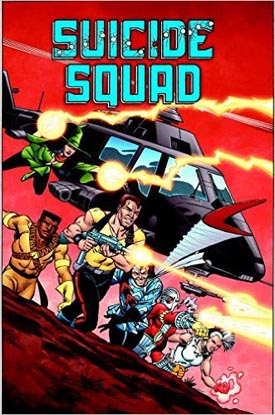 I first ran across the work of John Ostrander in his collaboration with Gail Simone in Secret Six: Danse Macabre. I had my reservations, but now that I’ve read what may be considered the forerunner to that series, Suicide Squad: Trial by Fire, I’m ready to ascribe the failings of Danse Macabre to an off day. This is actually the third incarnation of the Suicide Squad, and of a markedly darker cast than the others.
I first ran across the work of John Ostrander in his collaboration with Gail Simone in Secret Six: Danse Macabre. I had my reservations, but now that I’ve read what may be considered the forerunner to that series, Suicide Squad: Trial by Fire, I’m ready to ascribe the failings of Danse Macabre to an off day. This is actually the third incarnation of the Suicide Squad, and of a markedly darker cast than the others.
Amanda Waller has had a bellyful: she’s lost her husband and most of her children to life in the Projects, and it’s made her not bitter, but determined and merciless. She takes over Task Force X, a black ops organization, and sells the president on a new version: deep cover, operatives from the ranks of super-criminals operating out of the decrepit Belle Reve Penitentiary in Nowhere, Louisiana, a strike force without portfolio, expendable and possessing a high degree of plausible deniability. This collection describes their origins and the first few adventures that make them, however loosely, a team.
It’s an odd collection of misfits, and the membership tends to shift around over time, as some have their sentences commuted (the reward for success) or don’t return from a mission (the reward for failure). Their first assignment is to cancel a planned jihad, by a villain who has his own team of supervillains, followed by the “rescue” of a Soviet dissident from the gulag. (She doesn’t want to be rescued.) In between, there’s a plot by Darkseid and a self-appointed hero, William Hell, who’s not completely on the up-and-up.
OK — this one’s fun. There’s enough deep motivation and social/political commentary to engage a contemporary audience (did I mention that the president that Waller sells her idea to is a dead ringer for Ronald Reagan, who used plausible deniability before it had a name?) and enough action for any antsy teenager. And these are not nice people — they range from the dual personality of June Moon/Enchantress (the Enchantress keeps getting stronger and doesn’t like anyone much) to Deadshot (Floyd Lawton), the eternal outsider, and the thoroughly despicable Captain Boomerang (George Harkness), who can quite calmly watch his teammates being murdered — “petty and vindictive” seems descriptive enough. The Penguin even makes an appearance. The drawing style is Classic Adventure Comic, with an echo of the ’50s. In fact, this one’s a nice bridge between the bright, unambiguous action/adventure comics of the 1950s and ’60s and the darker, more morally fluid viewpoints we see now.
This collection includes Secret Origin #14 and Suicide Squad #1-8. And happily, it looks as though we can hope for more.
(DC Comics, 2011)
